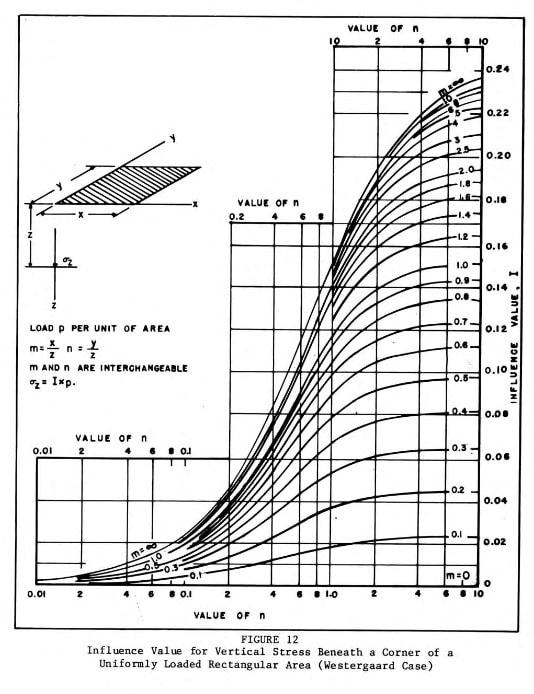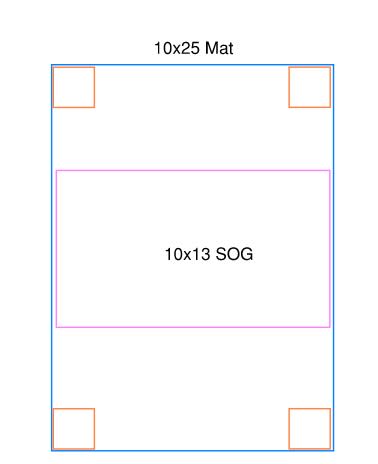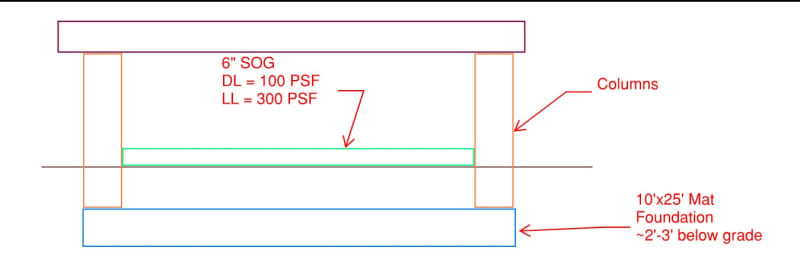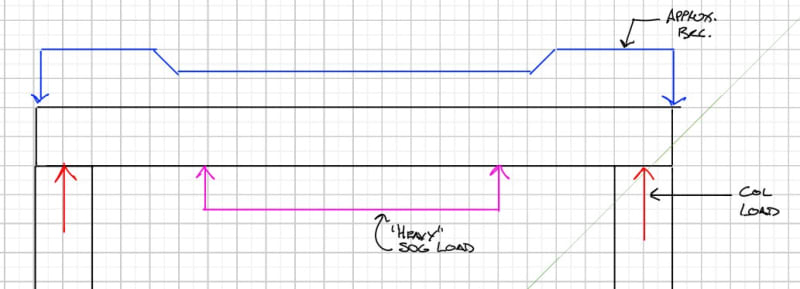Navigation
Install the app
How to install the app on iOS
Follow along with the video below to see how to install our site as a web app on your home screen.
Note: This feature may not be available in some browsers.
More options
Style variation
-
Congratulations MintJulep on being selected by the Eng-Tips community for having the most helpful posts in the forums last week. Way to Go!
You are using an out of date browser. It may not display this or other websites correctly.
You should upgrade or use an alternative browser.
You should upgrade or use an alternative browser.
Footing directly below Slab-on-Grade
- Thread starter jreit
- Start date
- Status
- Not open for further replies.
- Thread starter
- #7
If I assume say 12" of compacted fill underneath the SOG and then 2' from there to the top of the mat slab, would using Fadum's chart to calculate the reduced demand on the mat slab be a reasonable approach?
I would assume the DL and LL on the slab acts 2' above the top of the mat slab and use the chart accordingly.
To BA's point, I'll look at the design both with and without the SOG loading.

I would assume the DL and LL on the slab acts 2' above the top of the mat slab and use the chart accordingly.
To BA's point, I'll look at the design both with and without the SOG loading.

- Thread starter
- #9
My elevation view wasn't clear so I've attached a plan view also.
The pressure should be able to spread out and dissipate around the sides beneath the SOG.
Would you still consider that a confined condition resulting in 100% load transfer from the SOG to the mat?

The pressure should be able to spread out and dissipate around the sides beneath the SOG.
Would you still consider that a confined condition resulting in 100% load transfer from the SOG to the mat?

TRAK.Structural
Structural
Is your concern trying to optimize the mat, and thus you are trying to account for reduction of the magnitude in area loading from the slab as it spreads through the soil?
If so, I agree with others here, used spread footings under the columns.
If so, I agree with others here, used spread footings under the columns.
- Thread starter
- #12
Yes, exactly TRAK.Structural, I am trying to optimize the mat foundation design and use a reduced loading if possible.
The column spread footing is also a reasonable approach but the final call on that is made by other disciplines.
If we do go with the mat, would the Fadum chart approach to determine a reduced loading be reasonable?
The column spread footing is also a reasonable approach but the final call on that is made by other disciplines.
If we do go with the mat, would the Fadum chart approach to determine a reduced loading be reasonable?
TRAK.Structural
Structural
jreit - I'm not familiar with that chart, but the concept looks reasonable. As some others have stated though, I doubt the reduction in vertical stress from the spreading of the slab on grade load will have much effect on the structural design of the mat. This load should transfer straight through to the bearing soil below.
Just Some Nerd
Structural
Personally I would consider it largely safe to ignore the loading for the mat foundation design and only consider it relevant from a soil bearing pressure aspect. Whether you ignore any spreading out of the load or not, in my mind I would just assume the mat takes the load straight down rather than redistributing and reduce the soil's bearing capacity by the same amount, for simplicity.
----------------------------------------------------------------------
Why yes, I do in fact have no idea what I'm talking about
----------------------------------------------------------------------
Why yes, I do in fact have no idea what I'm talking about
- Thread starter
- #15
I want to make sure I'm understanding this correctly. The SOG really just transfers the 400 psf load directly down to the soil. That 400 psf is not resisted by the mat foundation directly. I should analyze the mat for the column loading and add 400 psf to the resultant soil pressure underneath the mat for the bearing pressure check.
I'm not sure how that 400 psf is getting underneath the mat? Why is it ok to not design the mat foundation for that 400 psf load?
I'm not sure how that 400 psf is getting underneath the mat? Why is it ok to not design the mat foundation for that 400 psf load?
jreit said:Why is it ok to not design the mat foundation for that 400 psf load?
Because the 400 psf load plus the weight of the mat are transferred directly to the subgrade. If you didn't have a mat, the grade slab would bear directly on the soil. The columns are putting tension on top of the mat, hence its weight and the 400 psf soil load are reducing the stress in the mat.
There is no reason mentioned so far, to use a mat. You should be using a footing under each column and omit the mat.
Turning it upside down is a good way to understand the statics of the situation, but remember that, even if the "SOG Load" is more than required to benefit bending in the mat, mat deflection is limited by the presence of the subsoil. If you insist on having a mat, its behavior should be treated as a mat on an elastic foundation. Unless there exists some convincing reason for using it, the mat should be omitted in favor of four separate footings.
- Status
- Not open for further replies.
Similar threads
- Replies
- 3
- Views
- 7K
- Replies
- 8
- Views
- 9K
- Question
- Replies
- 7
- Views
- 9K
- Question
- Replies
- 4
- Views
- 3K


